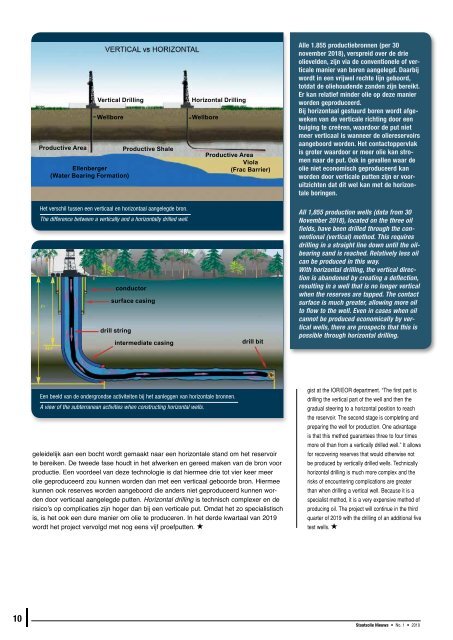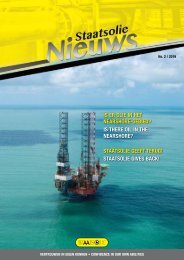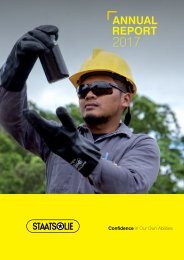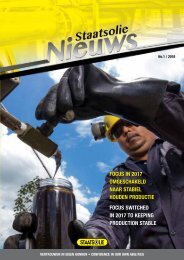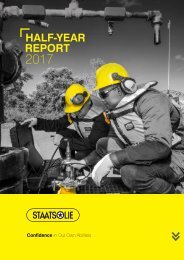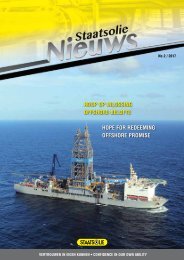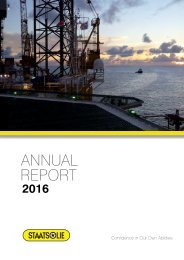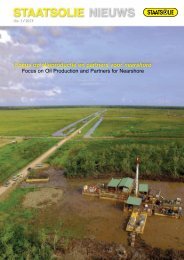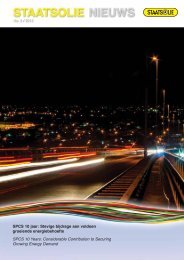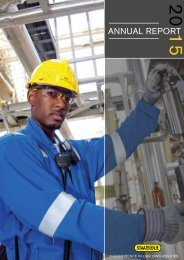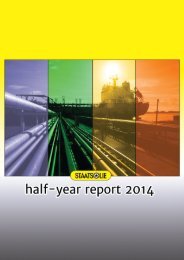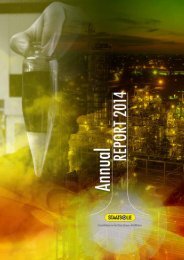Staatsolie Nieuws January 2019
Create successful ePaper yourself
Turn your PDF publications into a flip-book with our unique Google optimized e-Paper software.
Productive Area<br />
Vertical Drilling<br />
Wellbore<br />
Ellenberger<br />
(Water Bearing Formation)<br />
Het verschil tussen een verticaal en horizontaal aangelegde bron.<br />
The difference between a vertically and a horizontally drilled well.<br />
conductor<br />
surface casing<br />
drill string<br />
Productive Shale<br />
intermediate casing<br />
Horizontal Drilling<br />
Wellbore<br />
Productive Area<br />
Viola<br />
(Frac Barrier)<br />
drill bit<br />
Alle 1.855 productiebronnen (per 30<br />
november 2018), verspreid over de drie<br />
olievelden, zijn via de conventionele of verticale<br />
manier van boren aangelegd. Daarbij<br />
wordt in een vrijwel rechte lijn geboord,<br />
totdat de oliehoudende zanden zijn bereikt.<br />
Er kan relatief minder olie op deze manier<br />
worden geproduceerd.<br />
Bij horizontaal gestuurd boren wordt afgeweken<br />
van de verticale richting door een<br />
buiging te creëren, waardoor de put niet<br />
meer verticaal is wanneer de oliereservoirs<br />
aangeboord worden. Het contactoppervlak<br />
is groter waardoor er meer olie kan stromen<br />
naar de put. Ook in gevallen waar de<br />
olie niet economisch geproduceerd kan<br />
worden door verticale putten zijn er vooruitzichten<br />
dat dit wel kan met de horizontale<br />
boringen.<br />
All 1,855 production wells (data from 30<br />
November 2018), located on the three oil<br />
fields, have been drilled through the conventional<br />
(vertical) method. This requires<br />
drilling in a straight line down until the oilbearing<br />
sand is reached. Relatively less oil<br />
can be produced in this way.<br />
With horizontal drilling, the vertical direction<br />
is abandoned by creating a deflection,<br />
resulting in a well that is no longer vertical<br />
when the reserves are tapped. The contact<br />
surface is much greater, allowing more oil<br />
to flow to the well. Even in cases when oil<br />
cannot be produced economically by vertical<br />
wells, there are prospects that this is<br />
possible through horizontal drilling.<br />
Een beeld van de ondergrondse activiteiten bij het aanleggen van horizontale bronnen.<br />
A view of the subterranean activities when constructing horizontal wells.<br />
geleidelijk aan een bocht wordt gemaakt naar een horizontale stand om het reservoir<br />
te bereiken. De tweede fase houdt in het afwerken en gereed maken van de bron voor<br />
productie. Een voordeel van deze technologie is dat hiermee drie tot vier keer meer<br />
olie geproduceerd zou kunnen worden dan met een verticaal geboorde bron. Hiermee<br />
kunnen ook reserves worden aangeboord die anders niet geproduceerd kunnen worden<br />
door verticaal aangelegde putten. Horizontal drilling is technisch complexer en de<br />
risico’s op complicaties zijn hoger dan bij een verticale put. Omdat het zo specialistisch<br />
is, is het ook een dure manier om olie te produceren. In het derde kwartaal van <strong>2019</strong><br />
wordt het project vervolgd met nog eens vijf proefputten.<br />
gist at the IOR/EOR department. “The first part is<br />
drilling the vertical part of the well and then the<br />
gradual steering to a horizontal position to reach<br />
the reservoir. The second stage is completing and<br />
preparing the well for production. One advantage<br />
is that this method guarantees three to four times<br />
more oil than from a vertically drilled well.” It allows<br />
for recovering reserves that would otherwise not<br />
be produced by vertically drilled wells. Technically<br />
horizontal drilling is much more complex and the<br />
risks of encountering complications are greater<br />
than when drilling a vertical well. Because it is a<br />
specialist method, it is a very expensive method of<br />
producing oil. The project will continue in the third<br />
quarter of <strong>2019</strong> with the drilling of an additional five<br />
test wells.<br />
10<br />
<strong>Staatsolie</strong> <strong>Nieuws</strong> • No. 1 • <strong>2019</strong>


